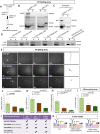A stop or go switch: glycogen synthase kinase 3β phosphorylation of the kinesin 1 motor domain at Ser314 halts motility without detaching from microtubules
- PMID: 34940839
- PMCID: PMC8722386
- DOI: 10.1242/dev.199866
A stop or go switch: glycogen synthase kinase 3β phosphorylation of the kinesin 1 motor domain at Ser314 halts motility without detaching from microtubules
Abstract
It is more than 25 years since the discovery that kinesin 1 is phosphorylated by several protein kinases. However, fundamental questions still remain as to how specific protein kinase(s) contribute to particular motor functions under physiological conditions. Because, within an whole organism, kinase cascades display considerable crosstalk and play multiple roles in cell homeostasis, deciphering which kinase(s) is/are involved in a particular process has been challenging. Previously, we found that GSK3β plays a role in motor function. Here, we report that a particular site on kinesin 1 motor domain (KHC), S314, is phosphorylated by GSK3β in vivo. The GSK3β-phosphomimetic-KHCS314D stalled kinesin 1 motility without dissociating from microtubules, indicating that constitutive GSK3β phosphorylation of the motor domain acts as a STOP. In contrast, uncoordinated mitochondrial motility was observed in CRISPR/Cas9-GSK3β non-phosphorylatable-KHCS314A Drosophila larval axons, owing to decreased kinesin 1 attachment to microtubules and/or membranes, and reduced ATPase activity. Together, we propose that GSK3β phosphorylation fine-tunes kinesin 1 movement in vivo via differential phosphorylation, unraveling the complex in vivo regulatory mechanisms that exist during axonal motility of cargos attached to multiple kinesin 1 and dynein motors.
Keywords: Drosophila; Axonal transport; CRISPR/Cas9; GSK3β; Kinesin 1; Phosphorylation; Processivity.
© 2021. Published by The Company of Biologists Ltd.
Conflict of interest statement
Competing interests The authors declare no competing or financial interests.
Figures




References
-
- Cahu, J., Olichon, A., Hentrich, C., Schek, H., Drinjakovic, J., Zhang, C., Doherty-Kirby, A., Lajoie, G. and Surrey, T. (2008). Phosphorylation by Cdk1 increases the binding of Eg5 to microtubules in vitro and in Xenopus egg extract spindles. PLoS ONE 3, e3936. 10.1371/journal.pone.0003936 - DOI - PMC - PubMed
Publication types
MeSH terms
Substances
Grants and funding
LinkOut - more resources
Full Text Sources
Molecular Biology Databases

